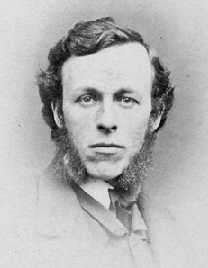
| Edward Sylvester Morse (1838-1925) was the Director of the Peabody Academy of Science, Professor of Zoology at the University of Tokyo, a Member of the National Academy of Science, and a Fellow of the American Academy of Arts and Sciences. This 1887 President of the American Association For the Advancement of Science wrote scores of books and papers, ranging from studies of various mollusks, Chinese and Japanese pottery, the artist Hokusai, suppression of unnecessary noise, the planet Mars, and the scientist Louis Agassiz. 1 |

|
Japanese Homes & Their Surroundings
(1886):
Flowers, shrubs, and dwarf trees in pots
and tubs are commonly used in the vicinity of the verandah, and also about
the garden for decorative features; and here tasteful and rustic effects
are sought for in the design and material of the larger wooden receptacles.
Figure 1 represents a shallow trough made from a fragment of an old shipwreck,
blackened by age, and mounted on a dark woodstand. In this trough
are two stones, a bronze crab, and a few aquatic plants.
Another wooden flower pot of large size
(Fig. 2) is made from the planks of an old vessel, the wood perforated
by Teredo
[shipworm]
, and the grain deeply worn out by age. Its form
permits it to be carried by two men.
In a large garden in Tokyo I saw one
of these trees that spread out in a symmetrical convex disk with a diameter
of twenty feet or more, yet standing not over 2 feet in height (Fig. 5);
still another one, in which the branches had been trained to assume the
appearance of flattened disks -- (Fig.6).
2
|
|
1 The National Union Catalog,
Vol. 396, pp. 318-323. Date of death corrected from 1935 to 1925
in personal e-mail to RJB from Dr. Andrew L. Maske, Curator of Japanese
Art, Peabody Essex Museum, 09/24/2004. Photo from
http://www.inhs.uiuc.edu/%7Eksc/Malacologists/MorseE.S.html.
2
Morse in
Bonsai,
BCI, Vol. XVII, No. 10, December 1978, pp. 340-341, with these six b&w
illustrations. "Reprinted by permission of Dover Publications, Inc.
New York. This article was submitted to the Editors of
Bonsai
courtesy of Mrs. Harold L. Krivoy, Northern Virginia Bonsai Society."
|